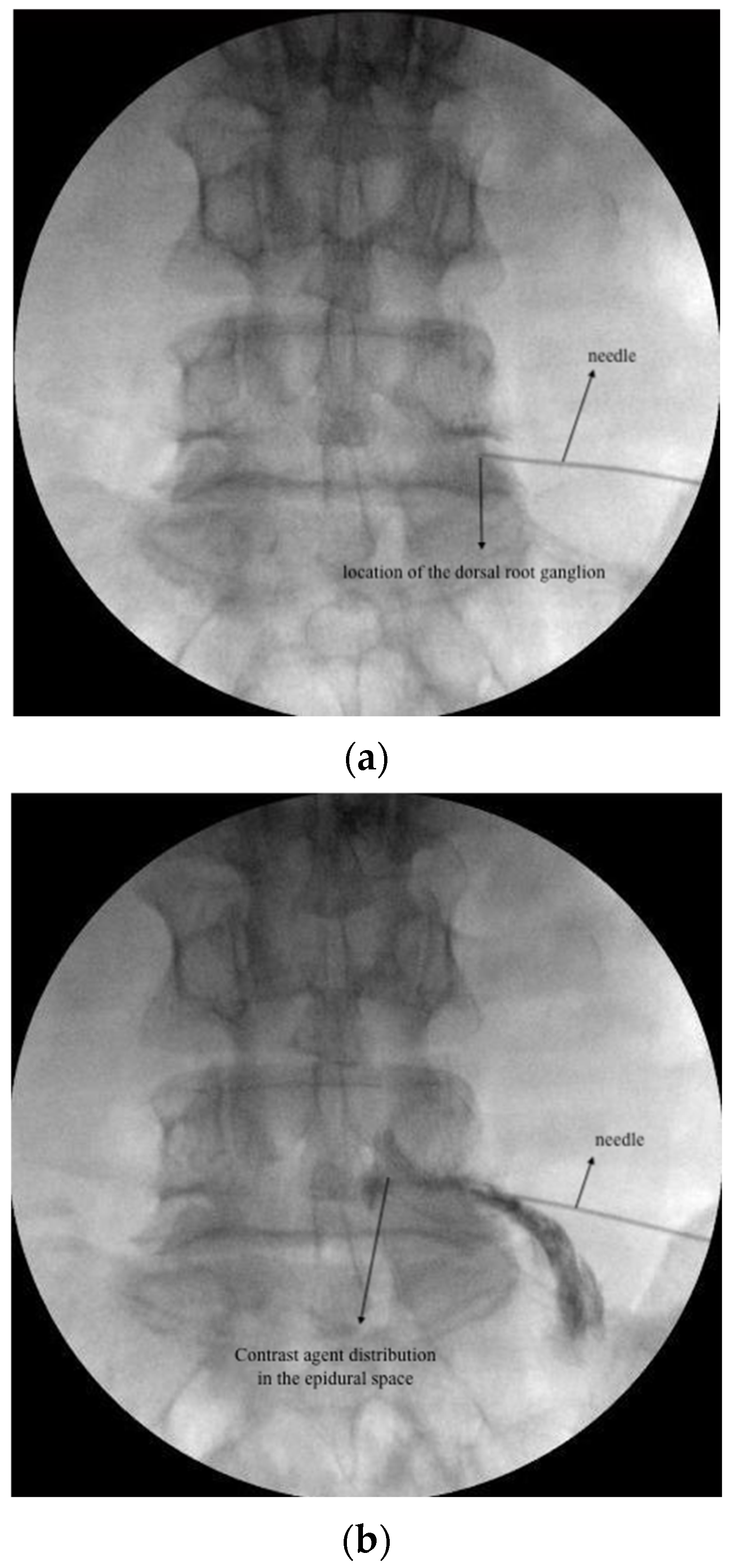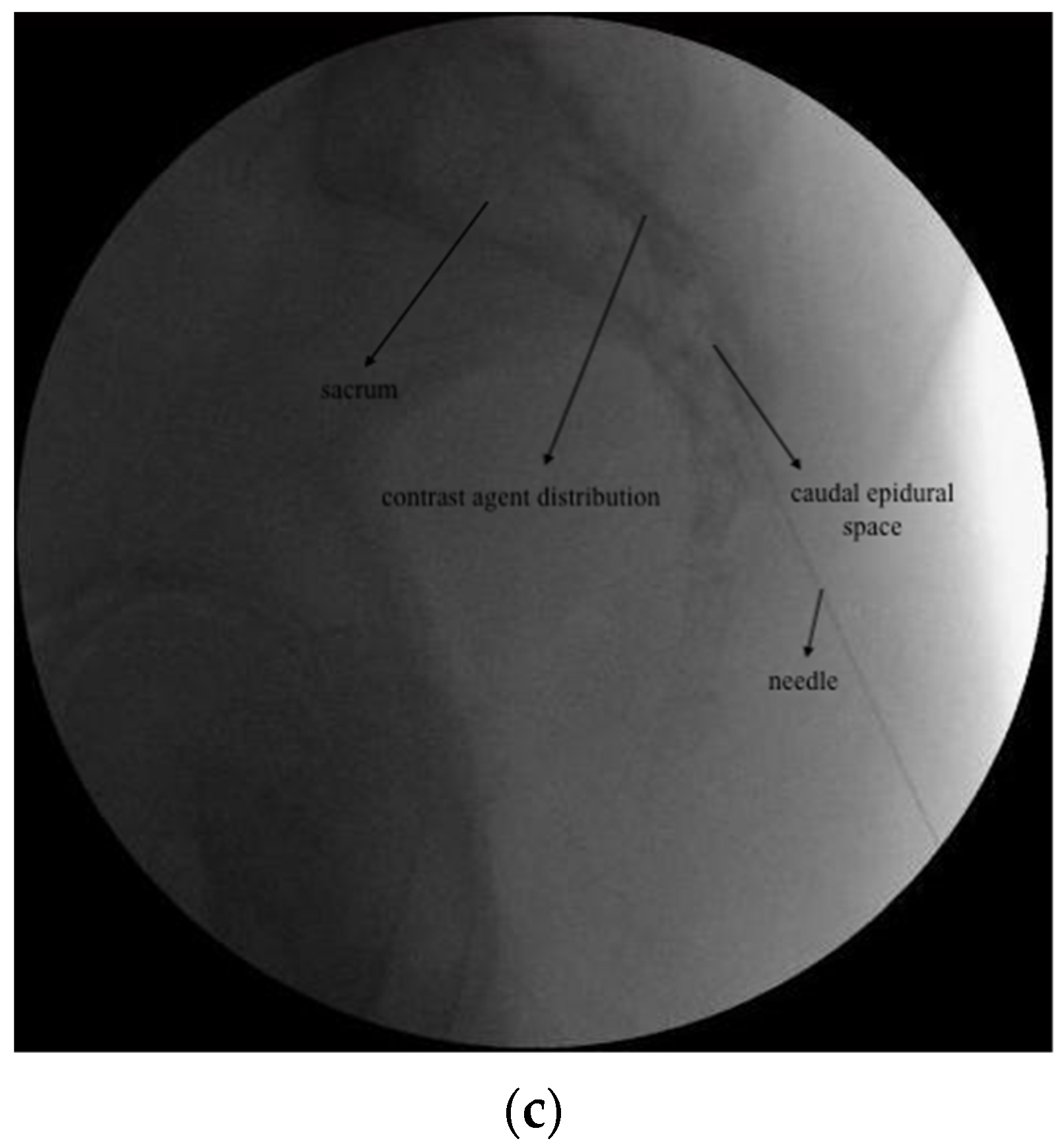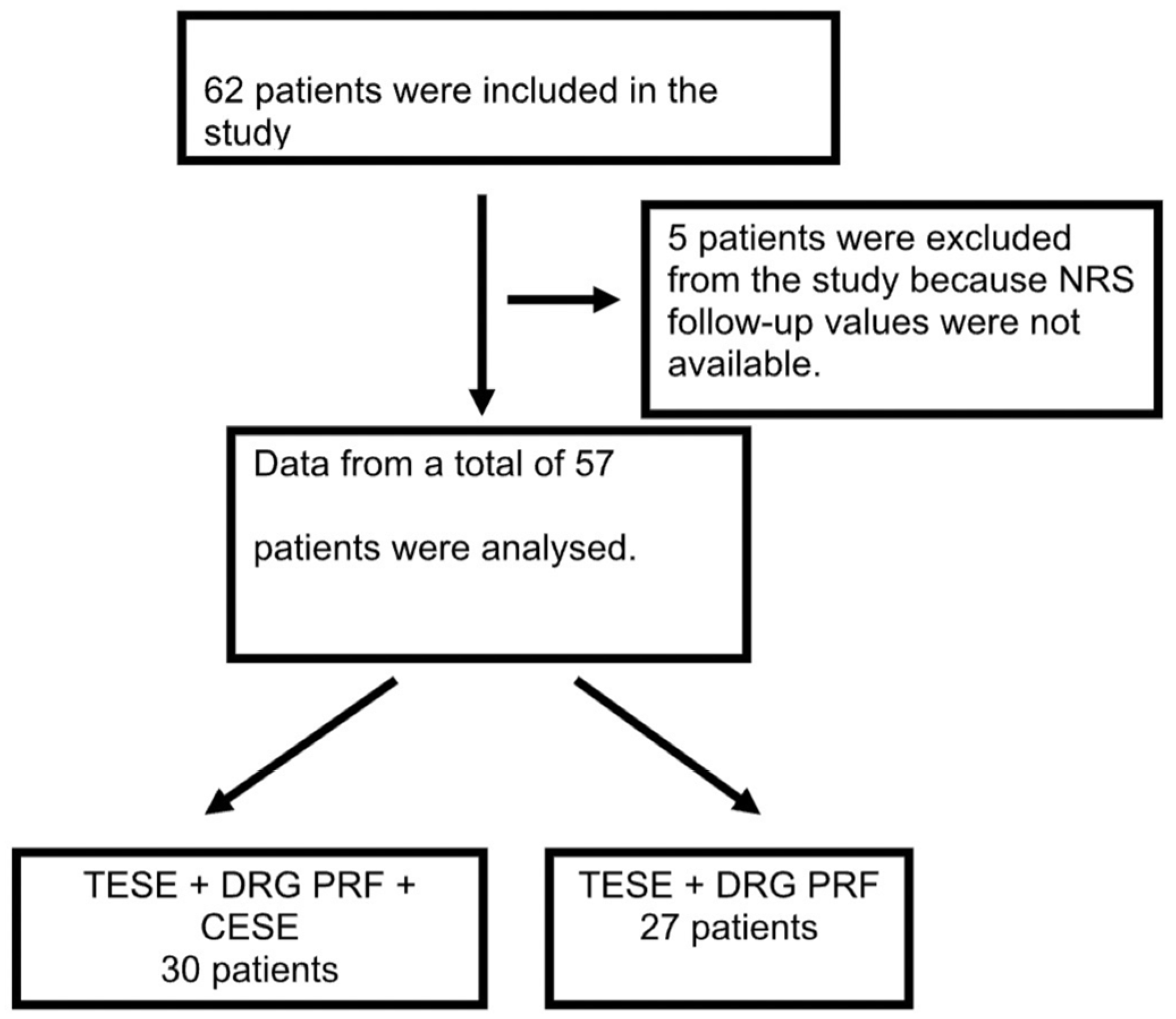Effect of Caudal Epidural Steroid Injection on Transforaminal Epidural Steroid Injection and Dorsal Root Ganglion Pulsed Radiofrequency in Recurrent Lumbar Disc Herniation
Abstract
1. Introduction
2. Materials and Methods
2.1. Ethical Approval and Patient Consent
2.2. Study Design and Participants
2.3. Intervention
2.3.1. DRG PRF and TESI
2.3.2. CESI
2.4. Outcome Measures and Follow-Up
2.5. Statistical Analysis
2.5.1. Sample Size Calculation
2.5.2. Data Analysis
3. Results
4. Discussion
5. Conclusions
Author Contributions
Funding
Institutional Review Board Statement
Informed Consent Statement
Data Availability Statement
Acknowledgments
Conflicts of Interest
References
- Hao, L.; Li, S.; Liu, J.; Shan, Z.; Fan, S.; Zhao, F. Recurrent disc herniation following percutaneous endoscopic lumbar discectomy preferentially occurs when Modic changes are present. J. Orthop. Surg. Res. 2020, 15, 176. [Google Scholar] [CrossRef] [PubMed]
- Suk, K.S.; Lee, H.M.; Moon, S.H.; Kim, N.H. Recurrent lumbar disc herniation: Results of operative management. Spine 2001, 26, 672–676. [Google Scholar] [CrossRef]
- Chen, Z.; Zhao, J.; Liu, A.; Yuan, J.; Li, Z. Surgical treatment of recurrent lumbar disc herniation by transforaminal lumbar interbody fusion. Int. Orthop. 2009, 33, 197–201. [Google Scholar] [CrossRef]
- Evran, S.; Kayhan, A.; Baran, O.; Saygi, T.; Katar, S.; Akkaya, E.; Ozbek, M.A.; Çevik, S. The Synergistic Effect of Combined Transforaminal and Caudal Epidural Steroid Injection in Recurrent Lumbar Disc Herniations. Cureus 2021, 13, e12538. [Google Scholar] [CrossRef] [PubMed]
- Karamouzian, S.; Ebrahimi-Nejad, A.; Shahsavarani, S.; Keikhosravi, E.; Shahba, M.; Ebrahimi, F. Comparison of two methods of epidural steroid injection in the treatment of recurrent lumbar disc herniation. Asian Spine J. 2014, 8, 646–652. [Google Scholar] [CrossRef][Green Version]
- Um, M.K.; Lee, E.; Lee, J.W.; Kang, Y.; Ahn, J.M.; Kang, H.S. Fluoroscopic lumbar transforaminal epidural steroid injections for recurrent herniated intervertebral disc after discectomy: Effectiveness and outcome predictors. PLoS ONE 2022, 17, e0271054. [Google Scholar] [CrossRef] [PubMed]
- Koh, W.; Choi, S.S.; Karm, M.H.; Suh, J.H.; Leem, J.G.; Lee, J.D.; Kim, Y.K.; Shin, J. Treatment of chronic lumbosacral radicular pain using adjuvant pulsed radiofrequency: A randomized controlled study. Pain Med. 2015, 16, 432–441. [Google Scholar] [CrossRef]
- Munjupong, S.; Tontisirin, N.; Finlayson, R.J. The effect of pulsed radiofrequency combined with a transforaminal epidural steroid injection on chronic lumbar radicular pain: A randomized controlled trial. Adv. Anesthesiol. 2016, 2016, 2136381. [Google Scholar] [CrossRef]
- Türkyılmaz, G.G. Factors associated with treatment success after combined transforaminal epidural steroid injection and dorsal root ganglion pulsed radiofrequency treatment in patients with chronic lumbar radicular pain. Turk. J. Med. Sci. 2022, 52, 1241–1248. [Google Scholar] [CrossRef] [PubMed]
- Süt, N. Sample size determination and power analysis in clinical trials. J. Turk. Soc. Rheumatol. 2011, 3, 29–33. [Google Scholar] [CrossRef]
- Faul, F.; Erdfelder, E.; Lang, A.G.; Buchner, A. G*Power 3: A flexible statistical power analysis program for the social, behavioral, and biomedical sciences. Behav. Res. Methods 2007, 39, 175–191. [Google Scholar] [CrossRef]
- Mariscal, G.; Torres, E.; Barrios, C. Incidence of recurrent lumbar disc herniation: A narrative review. J. Craniovertebral Junction Spine 2022, 13, 110–113. [Google Scholar] [CrossRef] [PubMed]
- Swartz, K.R.; Trost, G.R. Recurrent lumbar disc herniation. Neurosurg. Focus 2003, 15, E10. [Google Scholar] [CrossRef] [PubMed]
- Huang, W.; Han, Z.; Liu, J.; Yu, L.; Yu, X. Risk Factors for Recurrent Lumbar Disc Herniation: A Systematic Review and Meta-Analysis. Medicine 2016, 95, e2378. [Google Scholar] [CrossRef]
- Enke, O.; New, H.A.; New, C.H.; Mathieson, S.; McLachlan, A.J.; Latimer, J.; Maher, C.G.; Lin, C.C. Anticonvulsants in the treatment of low back pain and lumbar radicular pain: A systematic review and meta-analysis. Cmaj 2018, 190, E786–E793. [Google Scholar] [CrossRef] [PubMed]
- Chou, R.; Deyo, R.; Friedly, J.; Skelly, A.; Weimer, M.; Fu, R.; Dana, T.; Kraegel, P.; Griffin, J.; Grusing, S. Systemic Pharmacologic Therapies for Low Back Pain: A Systematic Review for an American College of Physicians Clinical Practice Guideline. Ann. Intern. Med. 2017, 166, 480–492. [Google Scholar] [CrossRef] [PubMed]
- Fu, J.L.; Perloff, M.D. Pharmacotherapy for Spine-Related Pain in Older Adults. Drugs Aging 2022, 39, 523–550. [Google Scholar] [CrossRef]
- Abdallah, A.; Güler Abdallah, B. Factors associated with the recurrence of lumbar disk herniation: Non-biomechanical-radiological and intraoperative factors. Neurol. Res. 2023, 45, 11–27. [Google Scholar] [CrossRef] [PubMed]
- Shepard, N.; Cho, W. Recurrent Lumbar Disc Herniation: A Review. Global Spine J. 2019, 9, 202–209. [Google Scholar] [CrossRef] [PubMed]
- Manchikanti, L.; Knezevic, N.N.; Navani, A.; Christo, P.J.; Limerick, G.; Calodney, A.K.; Grider, J.; Harned, M.E.; Cintron, L.; Gharibo, C.G.; et al. Epidural Interventions in the Management of Chronic Spinal Pain: American Society of Interventional Pain Physicians (ASIPP) Comprehensive Evidence-Based Guidelines. Pain Physician 2021, 24, S27–S208. [Google Scholar]
- Marliana, A.; Yudianta, S.; Subagya, D.W.; Setyopranoto, I.; Setyaningsih, I.; Tursina Srie, C.; Setyawan, R.; Rhatomy, S. The efficacy of pulsed radiofrequency intervention of the lumbar dorsal root ganglion in patients with chronic lumbar radicular pain. Med. J. Malaysia 2020, 75, 124–129. [Google Scholar] [PubMed]



| TESI + DRG PRF (n = 27) | TESI + DRG PRF + CESI (n = 30) | p Value | ||
|---|---|---|---|---|
| Sex | Female | 21 (77.8%) | 22 (73.3%) | |
| Male | 6 (22.2%) | 8 (26.7%) | 0.7 a | |
| Age (years) | 56.5 ± 13.9 | 58.8 ± 12.3 | 0.5 b | |
| Symptom duration (months) | 6 (3–60) | 6 (3–72) | 0.5 d | |
| Injection side | Right | 9 (33.3%) | 7 (23.3%) | 0.6 c |
| Left | 16 (59.3%) | 19 (63.4%) | ||
| Bilateral | 2 (7.4%) | 4 (13.3%) | ||
| Injection level | L4–5 | 4 (14.8%) | 8 (26.7%) | 0.5 c |
| L5-S1 | 4 (14.8%) | 4 (13.3%) | ||
| L4–5 and L5-S1 | 19 (70.4%) | 18 (60%) | ||
| Number of LDH surgeries | 1 | 14 (51.9%) | 17 (56.7%) | 0.9 c |
| 2 | 11 (40.7%) | 11 (36.7%) | ||
| ≥3 | 2 (7.4%) | 2 (6.6%) | ||
| MRI findings | No stabilization | 15 (55.6%) | 15 (50%) | 0.7 a |
| Stabilization | 12 (44.4%) | 15 (50%) | ||
| Medical treatment | Gabapentinoids | 17 (68%) | 14 (73.7%) | 0.7 a |
| Duloxetine | 6 (24%) | 3 (15.8%) | 0.7 e | |
| Opioids | 3 (12%) | 4 (21.1%) | 0.7 e | |
| NSAID | 2 (8%) | 2 (10.5%) | >0.9 e | |
| NRS Score | Pretreatment | 7 (6–8) (7 ± 0.7) | 7 (6–8) (7.3 ± 0.6) | 0.1 d |
| Posttreatment 1 month | 3 (0–7) (3.2 ± 1.6) | 3 (0–7) (2.9 ± 2) | 0.5 d | |
| Posttreatment 3 months | 3 (0–7) (3.4 ± 1.8) | 3 (0–7) (2.9 ± 2.2) | 0.4 d | |
| Posttreatment 6 months | 3 (0–7) (3.4 ± 1.8) | 3 (0–7) (3.1 ± 2.2) | 0.7 d | |
| TESI+ DRG PRF (n = 20) | TESI+ DRG PRF +CESI (n = 21) | p Value | ||
|---|---|---|---|---|
| Age (years) | 56.3 ± 13.3 | 58.2 ± 12.9 | 0.6 b | |
| Sex | Female | 17 (85%) | 15 (71.4%) | 0.5 e |
| Male | 3 (15%) | 6 (28.6%) | ||
| Symptom duration (months) | 16 (3–60) | 6 (3–72) | 0.2 d | |
| Injection side | Right | 6 (30%) | 5 (23.8%) | 0.9 c |
| Left | 12 (60%) | 14 (66.7%) | ||
| Bilateral | 2 (10%) | 2 (9.5%) | ||
| Injection level | L4–5 | 4 (20%) | 8 (38.1%) | 0.6 c |
| L5-S1 | 1 (5%) | 1 (4.8%) | ||
| L4–5 and L5-S1 | 15 (75%) | 12 (57.1%) | ||
| Number of LDH surgeries | 1 | 12 (60%) | 12 (57.1%) | >0.9 c |
| 2 | 7 (35%) | 8 (38.1%) | ||
| ≥3 | 1 (5%) | 1 (4.8%) | ||
| MRI | No stabilization | 13 (65%) | 14 (66.7%) | >0.9 c |
| Stabilization | 7 (35%) | 7 (33.3%) | ||
| Medical Treatment | Gabapentinoids | 11 (61.1%) | 7 (63.6%) | >0.9 e |
| Duloxetine | 5 (27.8%) | 1 (9.1%) | 0.6 e | |
| Opioids | 1 (5.9%) | 2 (18.2%) | 0.5 e | |
| NSAID | 2 (11.1%) | 2 (18.2%) | 0.6 e | |
| NRS | Pretreatment | 7 (6–8) (7.3 ± 0.6) | 8 (6–8) (7.5 ± 0.6) | 0.2 d |
| Posttreatment 1 month | 3 (0–4) (2.6 ± 1.2) | 2 (0–4) (2.1 ± 1.5) | 0.3 d | |
| Posttreatment 3 months | 3 (0–4) (2.6 ± 1.2) | 2 (0–4) (2 ± 1.5) | 0.2 d | |
| Posttreatment 6 months | 3 (0–4) (2.6 ± 1.2) | 2 (0–4) (2 ± 1.5) | 0.3 d | |
| No Stabilization (n = 30) | Stabilization (n = 27) | ||||||
|---|---|---|---|---|---|---|---|
| TESI+ DRG PRF (n = 15) | TESI + DRG PRF + CESI (n = 15) | p Value | TESI+ DRG PRF (n = 12) | TESI+ DRG PRF + CESI (n = 15) | p Value | ||
| NRS | Pretreatment | 7 (6–8) | 7 (6–8) | 0.7 d | 7 (6–8) | 7 (6–8) | 0.6 d |
| Posttreatment 1 month | 3 (0–7) | 2 (0–5) | 0.2 d | 7.3 ± 0.6 | 3.7 ± 1.9 | 0.8 b | |
| Posttreatment 3 month | 3 (0–7) | 2 (0–5) | 0.1 d | 3.8 ± 1.9 | 4.1 ± 2 | 0.8 b | |
| Posttreatment 6 month | 3 (0–7) | 2 (0–5) | 0.2 d | 3.8 ± 1.9 | 4.3 ± 1.9 | 0.5 b | |
| Used Pain Medication (n = 44) | No Pain Medication (n = 13) | |||||
|---|---|---|---|---|---|---|
| NRS | TESI + DRG PRF (n = 25) | TESI + DRG PRF + CESI (n = 19) | p Value | TESI + DRG PRF (n = 2) * | TESI + DRG PRF + CESI (n = 11) | p Value |
| Pretreatment | 7 (6–8) | 7 (6–8) | 0.2 d | 8 (6–8) | ||
| Posttreatment 1 month | 3.2 ± 1.6 | 3.4 ± 1.9 | 0.8 b | 1.9 ± 1.9 | ||
| Posttreatment 3 month | 3.5 ± 1.7 | 3.6 ± 2.1 | 0.9 b | 1.9 ± 1.9 | ||
| Posttreatment 6 month | 3.5 ± 1.7 | 3.8 ± 2 | 0.5 b | 1.9 ± 1.9 | ||
Disclaimer/Publisher’s Note: The statements, opinions and data contained in all publications are solely those of the individual author(s) and contributor(s) and not of MDPI and/or the editor(s). MDPI and/or the editor(s) disclaim responsibility for any injury to people or property resulting from any ideas, methods, instructions or products referred to in the content. |
© 2024 by the authors. Licensee MDPI, Basel, Switzerland. This article is an open access article distributed under the terms and conditions of the Creative Commons Attribution (CC BY) license (https://creativecommons.org/licenses/by/4.0/).
Share and Cite
Gazioğlu Türkyılmaz, G.; Rumeli, Ş.; Bakır, M.; Aşkın Turan, S. Effect of Caudal Epidural Steroid Injection on Transforaminal Epidural Steroid Injection and Dorsal Root Ganglion Pulsed Radiofrequency in Recurrent Lumbar Disc Herniation. J. Clin. Med. 2024, 13, 7821. https://doi.org/10.3390/jcm13247821
Gazioğlu Türkyılmaz G, Rumeli Ş, Bakır M, Aşkın Turan S. Effect of Caudal Epidural Steroid Injection on Transforaminal Epidural Steroid Injection and Dorsal Root Ganglion Pulsed Radiofrequency in Recurrent Lumbar Disc Herniation. Journal of Clinical Medicine. 2024; 13(24):7821. https://doi.org/10.3390/jcm13247821
Chicago/Turabian StyleGazioğlu Türkyılmaz, Gülçin., Şebnem. Rumeli, Mesut. Bakır, and Suna. Aşkın Turan. 2024. "Effect of Caudal Epidural Steroid Injection on Transforaminal Epidural Steroid Injection and Dorsal Root Ganglion Pulsed Radiofrequency in Recurrent Lumbar Disc Herniation" Journal of Clinical Medicine 13, no. 24: 7821. https://doi.org/10.3390/jcm13247821
APA StyleGazioğlu Türkyılmaz, G., Rumeli, Ş., Bakır, M., & Aşkın Turan, S. (2024). Effect of Caudal Epidural Steroid Injection on Transforaminal Epidural Steroid Injection and Dorsal Root Ganglion Pulsed Radiofrequency in Recurrent Lumbar Disc Herniation. Journal of Clinical Medicine, 13(24), 7821. https://doi.org/10.3390/jcm13247821





